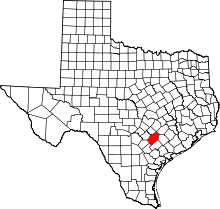Albuquerque, Texas
Albuquerque, Texas was a settlement established in 1857 by Samuel McCracken and Henry Hastings. Its population grew, and following the American Civil War, the town boasted a mercantile store, saloon, blacksmith shop, cotton gin, and an elementary school. Its U.S. post office opened in 1870. Albuquerque, Texas is today a ghost town.
History
Henry Hastings and Samuel McCracken, two brothers-in-law from Mississippi, were the town's first residents, settling the area "located on the Clear Fork of Sandies Creek" in 1857.[1][2] The town was originally thought to be in Wilson County, Texas, but was found to actually be in Gonzales County by a 1914 re-survey of county lines.[2] Official recognition of Albuquerque occurred in 1870 with the opening of the post office.[2] The McCracken family established a boarding house and blacksmith shop, and the town also had a store and saloon. There was an elementary school which operated during the 1870s and into the 1880s.
John Wesley Hardin's killings
The area was the site of two killings by the outlaw John Wesley Hardin.
- Death of Parramore Green
The first of Hardin's fatal actions in town was the killing of a black Texas Special Policeman, Private Parramore Green. The killing occurred in October 1871 when Green, and a Private John Lackey, confronted Hardin at the mercantile store in Albuquerque with the intent to arrest him. In the ensuing gunfight, Green was killed, and Lackey was left seriously wounded.[1][3] Hardin made good his escape and soon left the area, joining a cattle drive going up the Chisholm Trail.
- Death of Sheriff Jack Helm
The second fatality in town at the hands of Hardin was the murder which occurred on May 17, 1873, when Hardin and Jim Taylor ambushed Sheriff Jack Helm in the town square. Helm had recently moved to the area in order to perfect a cotton-wormer machine which he had invented. He was living at the McCracken boarding house, and found himself unarmed when approached by Hardin, having left his guns in his room while working on his invention at the blacksmith shop.[4]
Helm and Hardin had been adversaries in the ongoing Sutton–Taylor feud for several years at this point.[2] While being distracted by Hardin, Jim Taylor crept up on Helm from behind and attempted to shoot him, but his revolver misfired. As the startled Helm turned, Taylor managed to get off a shot, striking Helm in the chest. Helm rushed Taylor, but Hardin shattered Helm's arm with a shotgun blast.[5] Helm then fled into the blacksmith shop. While Hardin held the townspeople at gunpoint, Taylor chased down Helm and unloaded the remaining five bullets into his head.[6] As Hardin and Taylor mounted their horses and prepared to ride away, it is reported that witnesses heard them boast that they had accomplished what they had set out to do.[7]
Decline and abandonment
Albuquerque's decline was attributed to the growth of nearby Union, Texas (now Union Valley), which was two miles south of Albuquerque,[2] as well as the lack of railroad access.[1] The Albuquerque Post Office closed for good in 1883, just thirteen years after opening. The town itself was completely abandoned by 1912[2] and is today a Texas ghost town.
References
- 1 2 3 Albuquerque, TX; article; "Texas Escapes Online Magazine: Travel and History"; accessed September 2015
- 1 2 3 4 5 6 Albuquerque, TX; article; uploaded on June 9, 2010; Dunn, Roy Sylvan; "Handbook of Texas Online; published by the Texas State Historical Association; accessed September 29, 2015
- ↑ Hardin, John Wesley (1896). The Life of John Wesley Hardin: As Written By Himself. Seguin, Texas: Smith & Moore. ISBN 978-0-8061-1051-6. Retrieved 2015-09-29.
- ↑ Helm, Jack; article; Handbook of Texas online; published by the Texas State Historical Association; accessed September 2015.
- ↑ Hardin's Deadly Tools; March 12, 2012; article; by Spangenberger, Phil; "True West Magazine" (online); accessed September 2015
- ↑ Wise, Ken (September 2015). Hunter, Michelle, ed. "The Trial of John Wesley Hardin". Texas Bar Journal. Austin, TX: State Bar of Texas. 75 (9): 202. Retrieved September 2015. Check date values in:
|access-date=(help) - ↑ Rose, Victor (1880). The Texas Vendetta, or, the Sutton-Taylor Feud. J.J. Little & Co. Retrieved September 2015. Check date values in:
|access-date=(help)
Coordinates: 29°20′54″N 97°50′34″W / 29.34833°N 97.84278°W
